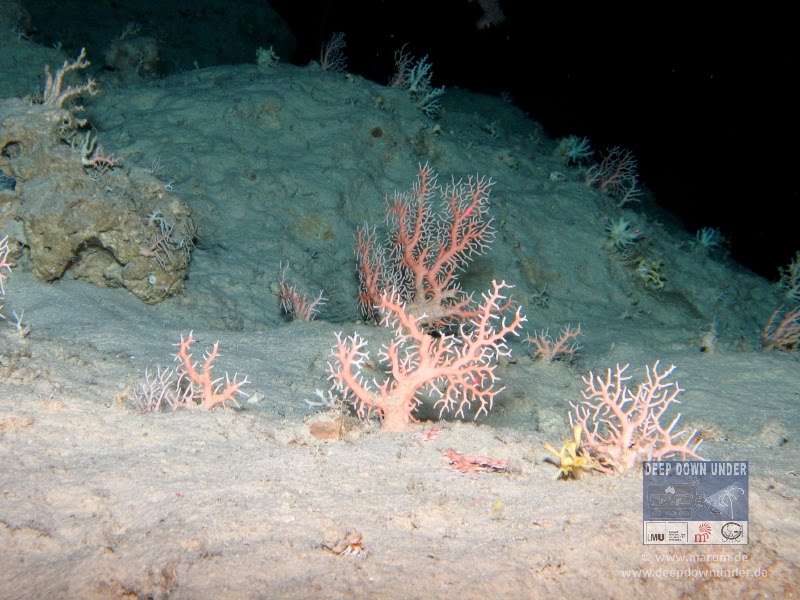|
|
Hard branching coral on unconsolidated substrate in very deepShort descriptionSubtidal mesophotic coral ecosystems in very deep water on unconsolidated substrates, dominated by branching hard corals. Disclaimer: Ecosystem type descriptions are based on biophysical attributes identified in Central Queensland through expert advice and supported by scientific literature. Not all ecosystem types are mapped based on current inventory, and many of the ecosystems described here may also occur in other parts of Queensland.
Classification categoriesSelect from the links below to view related ecosystem type categories Long descriptionSubtidal mesophotic coral ecosystems (MCEs, i.e. low light coral ecosystems) dominated by branching hard coral growing on unconsolidated or intermediate substrates in very deep water (below 30 metres depth). Hard corals if present are more likely to occur on boulders and gravel (e.g. coral rubble), as based on limited inventory of MCEs to date, macrobiota other than macroalgae is largely absent on mud and sand[2]. Mesophotic branching hard corals (genera Acropora and Isopora) below 40m depth are morphologically different from those in shallow water, having light and fragile skeletons, increased spacing between branches and corallites, forming laterally flattened branches. These changes may enhance their ability to capture light and cope with sediment that rains down from above. Some species are found in shallow, deep and very deep water and some are specialist mesophotic species only found in very deep water. They can form large monospecific stands and colonies, comparable to similar stands of branching coral in shallow waters[3], however this has been rarely observed (based on limited surveys). Mesophotic hard corals are also more likely to be heterotrophs, i.e. feeding on other biota rather than through photosynthesis[5]. Special valuesMesophotic ecosystems are potentially refugia from disturbance for coral species also found on shallow water ecosystems and include species tolerant to low light levels. Forty-five per cent of shallow reef coral species also occur in the mesophotic[4]. These ecosystems can provide protection from coral bleaching, however the mechanism for reduced bleaching at depth is complicated and appears to be related to Water temperature and/or light levels. In general, MCEs are also a refuge from the physical damage associated with storms and cyclones (Energy magnitude), apart from very intense ones. Coral reefs and communities (including MCEs) are highly valued for their diverse flora and fauna, fish habitat values, as commercial fisheries. The values of Queensland’s coral reefs are internationally recognised in the World Heritage (Great Barrier Reef) and many MCEs are found within its boundaries. The Outstanding Universal Value of the Great Barrier Reef World Heritage area is based on four criteria (vii), (viii), (ix), (x). Mesophotic branching hard coral ecosystems are diverse and have high species richness, with the potential to preserve evolutionary lineages of Indo-Pacific corals[4]. Diagnostic attributesInundation 'Subtidal' Benthic depth 'Very deep (>30m)' Structural macrobiota 'Hard coral – branching' Consolidation 'Unconsolidated', 'Intermediate', 'Unknown' QualifiersPotentially Naturalness qualifiers are relevant. Being able to be shifted by mechanical action means that these ecosystems can be potentially modified by trawling or dredging. DistributionA continuous line of submerged reefs extends along much of the shelf edge of the Great Barrier Reef in very deep waters[1]. Branching hard corals are more likely to occur on ‘reefal’ substrates (i.e. consolidated and unconsolidated boulders and gravels) based on limited inventory to date[2]. There is very little data for MCEs south of Townsville due to limited surveys. Deep water corals are most likely to occur in the lower latitudes. Lower latitude waters tend to have higher light levels than higher latitudes (everything else equal) due to the angle of the light and reduced path length through the water column (P. Muir, pers. comm.). Deep water corals may also occur in shaded microhabitats at higher latitudes, which also indicates the low light tolerance of these corals[4]. The flat tops of the ridges provided the best light for corals deriving their food from photosynthesis (phototrophic) and the steep slopes and sides of the ridges were dominated by corals capable of capturing planktonic prey (heterotrophic)[2]. The following relates to distribution of this ecosystem type within the Central Queensland mapping area:
CommentsVery deep water depth is associated with low light levels. Very clear water (Water clarity) is required for hard corals to grow in very deep water to enable sufficient light to reach the corals (P. Muir, pers. comm.). Other attributes include Terrain morphology, Terrain slope and Water temperature[2][3][4], Structural macrobiota, Benthic rugosity[2], Energy source (current/upwelling) and Energy magnitude[2]. Additional InformationWhat are Mesophotic Coral Ecosystems? - National Oceanic and Atmospheric Administration Mapping the life mesophotic - Marine Biodiversity Hub Exploration of relict faunas at Osprey and Shark Reefs - Deep Down Under Expedition References
Last updated: 12 July 2019 This page should be cited as: Department of Environment, Science and Innovation, Queensland (2019) Hard branching coral on unconsolidated substrate in very deep, WetlandInfo website, accessed 18 March 2024. Available at: https://wetlandinfo.des.qld.gov.au/wetlands/ecology/aquatic-ecosystems-natural/estuarine-marine/descriptions/80/ |

 — Department of Environment, Science and Innovation
— Department of Environment, Science and Innovation


